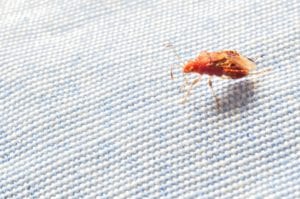Pest control
By calling in pest control, you can get rid of pests in your home quickly and easily. What do you look for regarding pest control, and what options are available? On this page, read more information about the costs, who is responsible, the species, the options and tips on preventing pests.
What are the pest control costs?
There are options to control pests yourself, but often this is not enough to get rid of pests forever. Hiring professional costs an average of £90 per project, but this depends very much on the type of pest, the size of the infestation and the hourly rate. See an overview of the average cost of pest control below.
| Type of pest | Average cost (incl. VAT) |
|---|---|
| Wasps | £ 60 – £ 90 per nest |
| Cockroaches | £ 100 |
| Mice | £ 65 – £ 90 per nest |
| Mice | £ 65 – £ 95 per nest |
| Woodworm and longhorn beetle | £ 300 per floor |
| Bedbugs | £ 750 – £ 1.500 per floor |
| Processed caterpillar | £ 200 – £ 350 per oak tree |
| Riddle flies | £ 50 – £ 150 |
| Ants | £ 100 – £ 150 |
| Fleas | £ 50 – £ 100 |
Find the best specialist for your project and get free quotes.
Start
What is pest control?
When you are bothered by pests in your home and want to get rid of them, you call pest control. It is partly possible to control pests yourself, for example, through mouse traps. If you are dealing with nests, it is wise to call in a specialist. Not sure what kind of pest you are dealing with? A professional expert unerringly recognises different types of pests and uses the right pesticides.
Who is responsible for pest control?
Who is actually responsible for pest control? You or the municipality? Pest control costs money, so knowing who should pay for it is good. If you yourself have caused pests by not sealing your rubbish properly, for example, you are responsible for controlling the pests.
Many people knock on the municipality’s door for pest control because the government is responsible for public health. In practice, the Housing Act says that pest control in homes should not be regulated by the government, as that is the responsibility of the citizen.

Types of pests
There are endless types of pests, but below, you will read about the most nuisance species.
Mice
Although mice look cute, they are not. Mice carry diseases and mark their territory with urine. You hear them rustling mainly in the evening and at night and find mouse droppings all over your house.
Fighting mice is possible in several ways. For instance, a mouse infestation can be controlled by a mouse exterminator who applies pesticides in your home. But mouse traps or pellets are also good options. Are you more of a fan of an animal-friendly method of control? Did you know you can chase away mice in your home with sound? Some transmitters for sale make an ultrasonic sound and thus chase away mice.
Wasps
Do you see excessive wasps around your house and in the garden? Then you probably have a wasp nest nearby. A wasp nest can consist of as many as 5,000 wasps. Wasps give out vicious stings when cornered, reason enough to fight the wasps and remove the wasp nest. Whether there is a wasp nest in the cavity wall or a wasp nest is located against the exterior of your home, a professional will help you get rid of it.
Woodworm
Have you noticed many holes in your woodwork? Then you are probably suffering from woodworms. Woodworms are larvae of certain beetles that attack your wood by eating it. Woodworms love untreated wood. Treating your wood with paint or stain, for example, makes it unattractive to woodworms. Is the harm done, and do you want woodworm removal? A professional specialist fights woodworm by means of poison or gas. After this, you will be rid of the woodworm infestation and the woodwork will remain healthy both from the inside and the outside.
Woodworm
The majority of woodworms are larvae of the longhorn beetle. These larvae also attack the woodwork in your home. Holes in your woodwork indicate that you are suffering from the longhorn beetle. You may also hear longhorn beetles. The sound of a longhorn beetle in the house is gnawing, which can be heard if you listen carefully. Fighting longhorn beetles is done in the same way as fighting woodworm, using poison or gas.
Silverfish
Silverfish in the home are a common problem in the Netherlands. They are small, silvery crawling insects that reproduce quickly. Silverfish are not otherwise harmful to humans, just annoying in the house. Where do silverfish come from anyway? Silverfish love a warm environment and because our houses are increasingly well-insulated, you find them more often in your home. Because silverfish love warmth, you sometimes find them in bed. It is a very unpleasant thought to have these creatures roaming around in your bed. If you find silverfish in your bed, you probably suffer from a serious infestation that you can no longer control yourself. A professional specialist will use a special pesticide and treat every nook and cranny of your home to ensure you’re really rid of them.
Cockroaches
When talking about scary insects, the cockroach soon comes up. Worldwide, cockroaches are persistent pests. A cockroach infestation is quickly formed, creating an average of 150 offspring every six months. Cockroaches can carry diseases and cause eczema, so it is important to control cockroaches. When people see a cockroach in the house, they often kick it to death. If you kick a cockroach to death, it is not a big deal per se, but make sure you clean up the eggs properly and clean the room before the eggs have a chance to hatch. The professional uses special insecticides to eradicate cockroaches. So you enjoy a pest-free home.
Bees
Bees can be recognised by their brown, hairy bodies. When they sting you, the sting remains on your skin. Bees are attracted to bright colours and sweet, strong-smelling perfumes. In addition, they often build nests against facades or in gardens. Are you suffering from a bee nest and want to eliminate it? Removing a bee nest is not allowed because the bee is a protected insect. To remove a bee nest, call a beekeeper. The beekeeper will move the bees to a better place, keeping them alive and preventing you from suffering from the bee nest.
Bed bugs
Bed bugs are also known as bed bugs or bed mites and are unwelcome guests in beds. You can recognise the presence of bed bugs by dark dander in your bed and brownish-black tiny droppings. Bedbugs bite and leave a red bump or stain on your skin with a bite. Fighting bedbugs yourself is tricky because it often involves large numbers of bedbugs hiding in different places. A professional is experienced in fighting bedbugs and knows where to apply insecticides.

What are the types of pest control?
There are roughly 2 types of pest control: chemical and natural. Check out the pros and cons of each method and the examples below.
| Advantages | Disadvantages | Examples | |
|---|---|---|---|
| Chemical | – A higher success rate of complete control – Easier to use – – Faster results |
– Toxic to humans and (domestic) animals – Bad for the environment – Can corrode materials – Pest species can become resistant |
– Poison – Gas – Adhesive strips |
| Natural | – No effect on the environment – Uses natural enemies – No toxic pesticides in the house – Animal-friendly |
– Difficult to control – Less complete control |
– Natural enemies – Moving and replacing planting – Natural barriers – Sealing cracks and holes – Fighting by ultrasonic sound |
How can you prevent pests in your home?
If you have successfully had your home pests controlled by a professional, it is important to prevent pests in the future. Here are some handy tips.
Method 1: seal packaging properly
Close food and drink packaging properly to prevent pests from entering. It is also wise to regularly check your cupboards and fridge for packaging that is past its date. This will minimise the opportunity for pests to enter your home.
Method 2: empty your rubbish containers regularly
Many kinds of pests love rubbish; this is where they eat and even lay eggs. Therefore, make sure you empty your waste containers regularly.
Method 3: holes and cracks
Pests enter your home in different ways, mainly through holes and cracks. This is also where the critters hide during the day. By sealing the gaps and holes in your house, you will not allow pests to enter or hide in your home.
Method 4: mosquito net expert
Ask a mosquito net expert to install mosquito nets for doors and windows to keep out pests such as wasps, bees and bumblebees. For example, if you suffer from a wasp’s nest on your facade, you can use mosquito nets to prevent them from entering your home.
Method 5: ventilate well
By ventilating your home well and regularly, you will make it less interesting for pests. In addition, a well-ventilated home is a difficult place for pests to survive, as they often love humid and warm spaces.
Tips when looking for a pest specialist
Will you hire a professional to control the pests in your home? Here are some handy tips on how to find the best pest specialist for you.
Tip 1: pay attention to seals of approval
Certificates exist for different industries, including the pest control industry. The hallmark you can look out for in a pest control specialist is NVPB. The NVPB is the trade association for quality in pest management. Member companies must meet the quality requirements set by the NVPB.
Tip 2: compare quotations
The cost of pest control differs not only per type of pest but also per specialist. Therefore, requesting several pest control quotes and looking at what the different specialists offer is advisable. This way, you can choose the best specialist for the best price.
Find the best specialist for your project and get free quotes.
Start